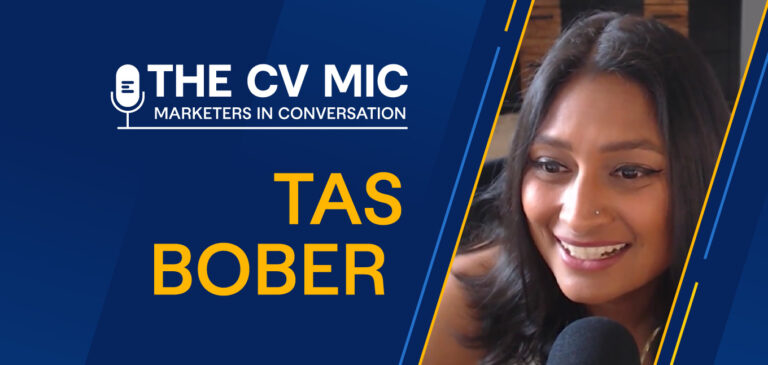When most people think about B2B marketing, their minds jump straight to metrics: conversion rates, revenue growth, campaign performance. For Tas Bober, founder of The Scroll Lab, success has another dimension. She’s built a consultancy that not only helps companies improve their landing pages but also gives her the freedom to design a workweek that fits her life.
In her conversation with us on the CV MIC (Marketers in Conversation), Tas offered an honest (and often funny) take on why optimizing for life and optimizing for marketing aren’t as different as they seem.
Building a Business Around a Three-Day Workweek
Tas didn’t set out to become the “purple landing page lady” of LinkedIn. After leading digital teams in-house for 15 years, she eventually decided to build something of her own. But unlike many founders chasing 10X growth, Tas focused on creating a rhythm that prioritized family, sanity, and balance.
Her solution? A three-day workweek.
At first, it was chaos. Three days of back-to-back meetings inevitably bled into late nights, weekends, and stolen hours while her kids napped. The turning point came when she stopped trying to do everything herself. Instead of hiring “just anyone,” she sought out copywriters who were better than her in specific areas. It stung to send those invoices, but the payoff was enormous: quality work, less stress, and more time back.
As she puts it, her consultancy isn’t designed around ambitious revenue goals — it’s designed around what she calls the trifecta: financial comfort, meaningful work, and time back.
From Conversion Rate Optimization to Consumption Rate Optimization
For years, marketers have obsessed over conversions. (Cough, cough: CRO) But Tas makes a strong case for shifting the focus earlier in the journey. She argues that conversions are a lagging indicator. By the time someone fills out a form, they’ve already done most of their research elsewhere.
Instead, she emphasizes consumption rate optimization: understanding how visitors interact with information before they ever reach the form. Heat maps, scroll depth, and session recordings reveal the moments where people get stuck, skim, or disengage. And those insights often matter more than the final conversion number.
For example, a single FAQ buried on one client’s landing page turned out to be a traffic magnet. Once Tas turned it into a standalone block, conversions skyrocketed by more than 250 percent. It wasn’t a clever new CTA or a flashy redesign. It was simply meeting visitors where their attention naturally gravitated.
The takeaway? Conversions start with consumption. If people aren’t engaging with your story, they won’t take the next step.

Writing for the Mode, Not Just the Medium
Tas has a knack for deflating marketing clichés with humor. Take the idea that “no one has an attention span anymore.” She’ll be the first to point out that people will binge an entire season of Love Is Blind or stay up until midnight reading a fantasy novel. Clearly, attention spans aren’t shrinking; they’re selective.
That’s why she stresses writing for the mode. On LinkedIn, people expect short, punchy posts. On a corporate blog, they expect more depth. On a landing page, they expect clarity and relevance. The medium matters, but the mindset matters more.
And clarity doesn’t mean dumbing things down. Tas encourages writing at an eighth-to-tenth-grade reading level, not because buyers aren’t savvy, but because everyone’s busy and overloaded. As she says, humans are built for efficiency — if there’s a simpler way to consume information, that’s the way we’ll choose.
Cutting Buzzwords and Keeping It Real
One of Tas’ favorite hacks is also one of the most humbling: run a buzzword count on your landing page copy. If the words “innovative,” “synergy,” or “game-changing” show up more often than actual benefits, you’ve got a problem.
The issue isn’t just readability. Buzzwords are a signal that the page was written for the company, not the buyer. Executives and decision-makers want specifics, not slogans. For technical audiences like InfoSec, that might mean more detail and proof points. For marketers, it might mean brevity and storytelling. Either way, jargon undermines trust.
Her advice is simple: if you wouldn’t say it out loud without cringing, don’t put it on your page.

Why Content Teams Should Step Into the Conversion Conversation
Landing pages often turn into what Tas calls a “quilt” — stitched together from the opinions of multiple stakeholders. Product marketing adds messaging. Sales adds objections. Content tries to smooth it out. The result is rarely cohesive.
Her solution is to flip the process. Start with a buyer’s business case, not a stakeholder’s wishlist. Ask the questions that matter most to buyers:
- What problem are we solving?
- Why are we better than alternatives?
- What proof supports our claims?
- How much does it cost?
- What happens after someone submits their info?
When landing pages answer those questions, they become tools buyers can actually use to secure internal approvals, not just placeholders in a campaign. And for content teams, this approach transforms their role from “wordsmith” to strategic partner.
The Future of Landing Pages: Conversational, Not Static
Looking ahead, Tas predicts websites will become less about static menus and more about conversational interfaces. Imagine typing questions directly into a brand’s site — “How do you compare to X competitor?” or “What’s your pricing model?” — and getting an instant answer.
AI will accelerate that shift, but the quality of the output will still depend on the inputs. Companies that document and publish clear, context-rich information will have the advantage. Those who rely on jargon and buzzwords will find their AI assistants sounding just as empty as their web pages.
For Tas, that’s actually good news. It means marketers who do the foundational work, research, clarity, and storytelling will only become more valuable.

Bringing It All Together
Tas Bober blends humor, honesty, and deep expertise to show that better landing pages — and better marketing overall — don’t come from chasing gimmicks. They come from doing the work: researching your audience, simplifying your story, and respecting how people actually consume information.
At ClearVoice, we believe the same. Content is the connective tissue between strategy and outcomes, the glue that holds campaigns together and drives results. If you’re looking to strengthen that connection for your brand, explore more CV MIC conversations or connect with ClearVoice to see how our team of experts can help.
Catch More CV MIC Conversations
If you found Tas’ insights valuable, don’t miss these other episodes:



